Characteristics and description of the tomato variety Honey giant, its yield
Characteristics and description of the variety Honey giant will certainly interest all lovers of large-fruited tomatoes. The variety of domestic selection is quite new, in the State Register since 2001. In the southern regions, the tomato can be grown outdoors, in the middle lane it will be more comfortable in a polycarbonate greenhouse.
Description of fruits
Amateur vegetable growers are attracted by the size of the fruit. With good care, they can grow up to 1 kg, this is a very impressive size, corresponding to the name. A beginner is unlikely to get such a result. With average care, the weight of the fruits is around 400 g.
The fruits are round in shape, slightly flattened. The skin is thin, yellow in ripe fruits. The pulp in the cut is pink-yellow, juicy, contains up to 6% of dry matter.
The honey giant is grown for sale by small farms. They are satisfied with such characteristics as keeping quality and resistance of fruits to mechanical damage during transportation.
Variety characteristics
The plant is of an indeterminate type. The bushes grow up to 1.5 m, they require a mandatory garter to the trellis or to the support in the form of a stake.
It is recommended to carry out the formation of a bush in 1 or 2 stems and regular removal of stepsons.
In terms of ripening, the Honey Giant belongs to the group of mid-early tomatoes. The fruits begin to sing at 100-110 days from germination. The variety is promising in relation to infections, it is rarely exposed to diseases and does not require chemical treatment.

To obtain fruits of the declared size, the variety needs fertilizers. It can be as complex fertilizers for tomatoesand mineral, containing nitrogen, potassium, phosphorus and other trace elements necessary for the full development of plants.
Large and tasty fruits are used for making salads and salted for the winter. Due to their large size, canned food is not made from them. The production of juice and tomato paste is also not practiced.
Yield
The yield indicator is one of the most important characteristics of the variety. According to it, vegetable growers determine whether they need this variety and how many bushes it costs to plant to provide the family with fresh tomatoes.
The yield of one plant of the Honey Giant is 4-5 kg. From 1 m², you can expect a tomato yield of 15 kg if you follow the standard planting scheme of 3 plants per 1 m².
Advantages and disadvantages
First, we note the lack of the variety, it is only one - the fragility of the branches loaded with fruits. There are much more advantages:
- High yields.
- The taste is excellent.
- Tomatoes tolerate transportation well.
- Keeping quality is excellent.
- Resistance to infections is high.
- Not susceptible to temperature fluctuations and bad weather conditions.

Reviews
On the Internet, it is easy to find reviews about the honey giant tomato. Many summer residents planted it on their plots.
Alina, Tver region
Growing the Honey Giant fell on the summer, which was not the most favorable for tomatoes: cold, rain, lack of sun. The taste of the fruit fell short of the assessment, but the yield and size of the tomatoes did not disappoint.
Alena, Moscow region
I did not guess with the dressing, the bush began to fatten and few fruits were formed. I think it was my mistake, not my grade.
Ilya, Moscow region
I cannot boast of the fruits of the giants. The size of the tomato is quite average, but the number of tomatoes from the Honey Giant made me happy. A productive variety.
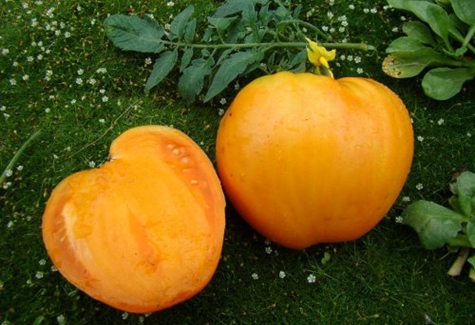
Olga, Moscow region
For several years in a row I used seeds from Aelita, and the variety pleased large tomatoes remarkably sweet taste. The flesh was fleshy and juicy, with a beautiful pink tint. This spring I bought seeds in another bag and the current tomatoes are not at all like the Honey Giant of yesteryear. Apparently a re-grade.
Nadezhda, Leningrad region
I planted honey giant tomatoes in a greenhouse. The bushes have grown higher than stated. All were under 2 meters tall. Led in 2 stems. The tomatoes have grown of good shape and excellent taste. I will definitely plant it next year.
Irina, Tver
She released her seeds last fall, planted today. We ate delicious tomatoes since July. I really like the variety: the taste is wonderful, there are few seeds, the tomatoes lie for a long time and do not deteriorate.
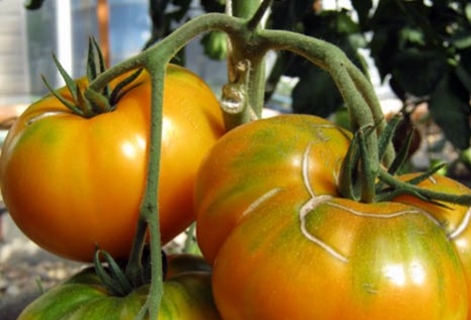
Planting and caring for giant tomatoes
Planting and caring for giant tomatoes is no different from caring for regular small-fruited tomatoes. It is imperative to remember that it is easier to get large fruits on fertile, loose soil than on heavy, loamy soil.
The timing of planting seeds for seedlings in the middle lane is standard. At the end of February, seedlings are sown for planting tomatoes in a greenhouse. In mid-March, seeds are sown for planting seedlings in open ground.
In order for the seedlings to grow strong, not to stretch in length, you need:
- Maintain the temperature in the room during the daytime at 18 ° C, at night 10-15 ° C.
- In cloudy weather, illuminate boxes with seedlings with fluorescent lamps.
- Feed two times with complex fertilizer for tomatoes.
- Dive into separate cups.
- In the last week before transplanting into the ground, harden.
- Water in moderation, avoiding stagnant water.
Transfer to soil
Transplant seedlings at the age of 55 days into prepared holes. Maintain the distance between the bushes at 40 cm. Make the row spacing wider (60-70 cm) for line planting.
Disinfect the stakes in advance and drive them next to the holes. Prepare soft knits. Add humus, ash, superphosphate and potassium nitrate to the wells. After transshipment of tomato seedlings, water the wells well and sprinkle with a layer of compost or humus (3-5 cm).
How to form a bush
Tie the bushes to stakes (trellises) 7-10 days after transplanting. Leave the stepson under the first flower brush. It is needed to get the second stem. Pluck out all other stepsons that appear in the axils of the central trunk, leaving a stump 1 cm high in place.
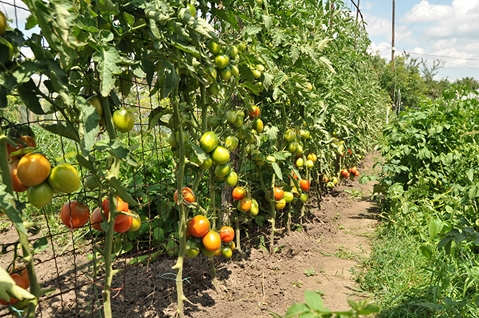
Disease Prevention and Pest Control
Fungal diseases rarely affect the Honey Giant. If this happens, it is through the fault of the grower. He does not monitor the humidity of the air and soil in the greenhouse.
Pests to be wary of:
- thrips;
- aphid;
- bear;
- whitefly;
- slugs.

The list of drugs with which any summer resident will cope with tomato pests:
- Bison from aphids and thrips.
- Whitefly Confidor.
- Mustard from slugs and bears.
- Red hot pepper from slugs and a bear.
Conclusion
Timely sowing of seeds for seedlings, quality care is what you need to get giant, tasty yellow tomatoes.Delight yourself and your family by making the right variety choice.
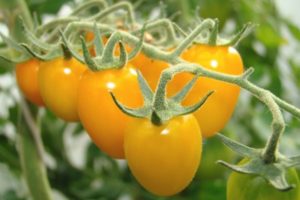
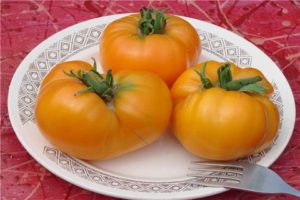
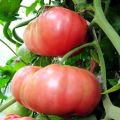





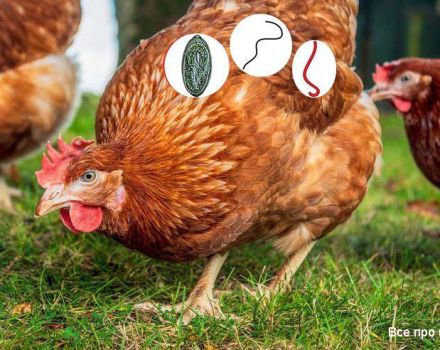

Just a wonderful variety, sweet, fleshy, with a thin skin. It just melts in the mouth, in our family we eat these tomatoes just with salt, they are delicious without any additives in the form of mayonnaise or sour cream. And this summer the yield just went off scale, I used the BioGrow bioactivator. I tried to salt this variety with a simple ambassador, in cans and under a nylon lid. Tomatoes turned out excellent, sharp, refreshing! I bought it in this store.